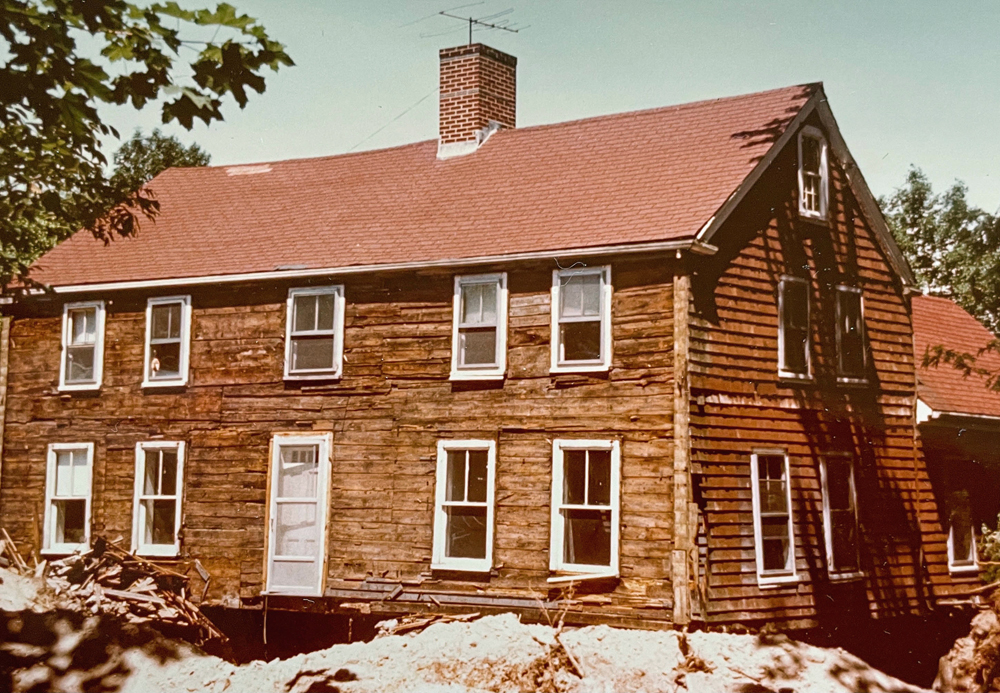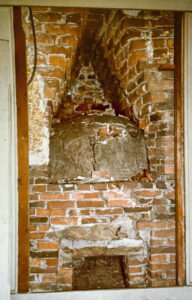True Tales from Canton’s Past: A House Once Read
By George T. ComeauAs I write this story, beside me on my desk is a 9×11-inch, brown Accogrip folder — the kind that has the spring clamp that holds down the papers contained therein. In the age of the internet, the folders likely aren’t seen very much these days. The small file is actually the medical report for a very old house that no longer exists. Inside are several neatly typed pages written in May 1975 by Frederic Detwiller, a well-known architectural historian who had been summoned to Pleasant Street to “read a house.”
Gerald Morris moved to Canton in the mid 1960s. Morris was a writer for the Quincy Patriot Ledger, and a fellow writer by the name of Beverly Houvinen had extolled the virtues of life in Canton. Morris had lived in Hyde Park, Roslindale and Norwell. Canton was beyond his reach financially. Undaunted, though, a local realtor and town historian named Katherine Sullivan encouraged him to place an offer on a house at 630 Pleasant Street. An offer was accepted and for $21,000 Morris moved to Canton to a house with two bathrooms and a two-car garage. Children grew up here and by the mid 1970s Morris and his first wife went their separate ways. A second wife brought along her two children and a larger house was needed.
On the west side of Pleasant Street, quite near Pequitside Farm and just across from Oak Road, sat a very, very old house. The Gill House had an ancient deed that dated to 1725. The house was actually even older than the deed itself. Originally the land had been purchased by Benjamin Gill on 200 acres that had been leased to his father by the native Indians. The land had extended on both sides of Pleasant Street from Pequit Brook up to Sherman Street. The deed in 1725 accounted for 172 acres of land. The house was standing in 1716 and was likely the home of Moses Gill, one of the first settlers of the town. That is the house that Morris bought in September 1974 for $26,000 from Michael and Frances Loughran. The purchase was in preparation for selling the house that he had lived in for eight years. The intent was to restore the Gill House and move there in support of a larger family.
Morris, now 83 years old, lives in Maine with his second wife, Mary Beth. Still recalling that old house, he noted, “It was in rough shape and I couldn’t fall in love with it.” Yet Morris knew it had antique bones. “I had great intentions to save that house, and had a brand-new foundation poured to move and stabilize the structure,” he said. Morris reached out to the Society for the Preservation of New England Antiquities (SPNEA) and they sent Detwiller to do the historical analysis and investigation.
Reading a house is still common today. The way an old house is built can tell reams about the history, provenance and age of a building. The way the beams come together, the types of joinery, nails, materials, paint samples, wallpaper, finish carpentry — all tell a story that old house detectives can study and surmise upon. In the case of the Gill House, Detwiller instantly saw a treasure of epic proportion. The earliest portion dated to the late 17th century, which made it one of the earliest surviving houses of the contact period between natives and English settlers in Canton. Interior oak sheathing, diagonal lathe and vertical beaded boarding placed that section of the building to between 1698 and 1710.
And, like so many First Period structures, there were additions over time. In the mid-18th century the house had been doubled in size. The chimney had been rebuilt, and glorious wood paneling appointed the rooms. It was, however, in tough shape and so more investigation ensued.
The clues in the dates of the building’s evolution came from circular sawn lumber, framing techniques and hand-cut nails. Fragments of 18th century paneling remained “scattered throughout the house.” Chamfered edges on the summer beams and lamb’s tongues edges all told the story. When one of the interior panels was removed, an 18th century chimney and oven were discovered. The house held so many wonderful secrets that dated back 300 years.
Think about the men and women who once sat by candlelight in the 17th century dining room. Above, large tapered beams caried the span and weight of the second floor, the bedroom above with unique corner posts and simple details recalling hand-hewn construction techniques. Wrought iron nails from the late 1600s gave way to cut nails in the 1700s. One bedroom was a pristine example of mid-1700 fit, finish and style. The attic told the story in the gable studs, framing and changes over the years. Wide pine floors, likely some of the earliest in our town’s history, echoed with the bootheels of the pioneers who founded the town.
The Boston Globe sent out Peter Hotton to write a profile for the Home and Garden section of the Sunday edition that ran in July 1975. Morris was now a Boston Globe travel editor and impressed upon his friend to share the story of the architectural sleuthing. “The pocket knife was a handy tool for the consultant,” Hotton wrote. “They used it to scrape bits of paint off to see what was underneath (sometimes they found Colonial brown and even yellow ochre); or to pry bits of molding off to see what the nails were like and if the moldings were original (sometimes, if there is no painted wood under the molding it is original).”
By the time the Globe article was published, Morris had removed a more modern front porch and had begun preparations to move the house. A new foundation was poured and the move began. Hotton noted, “So you can make a silk purse out of a sow’s ear, but admittedly this sow’s ear only looked like a sow’s ear.” The final sentence: “Just wait till it’s finished.” However, this was not to be.
In order to make the project work, the Zoning Board of Appeals would have had to allow a variance for the side yard clearance. But the ZBA, to this day, has little appetite for historic preservation, and generally favors demolition of our most precious assets at the request of developers who seek to maximize the highest and best use of the land. Countless examples exist where we have lost heritage to modern and intractable decisions made to benefit developers and builders at the expense of our historical treasures. This may sound harsh, with apologies to these men (yes, all men) who have made these decisions, but as they say, “It is what it is.”
In the end, Morris decided that the house was like a sweater with a pull — the repair would be insurmountable and he opted for a modern subdivision with four houses. When the Planning Board pressed Morris to name the new street that would become his new home, he looked across the table and said “Morris Drive.” The Gill House was demolished, the new foundation removed, and a four-lot subdivision and cul-de-sac sprang up. The Morris family lived happily in a new modern home at No. 8 for over 20 years.
Last weekend, my brother Christopher and I traveled a few hours north to Maine and visited with Gerry and Mary Beth. We saw beautiful photos of their family and enjoyed a few moments reminiscing over our shared love of Canton. Inside a box of local memories that the Morrises donated to the Canton Historical Society was the Accogrip folder. In the back of the pickup truck we carried back an 18th century painted panel that once graced the hallway and had covered the chimney. The Morrises were downsizing and moving to a new home, but they gave back a piece of our history that spans more than three centuries. The lesson of loss is bitter, and progress usually will win the day. For the generations that come ahead, all that remains of the Gill House are a handful of Kodak memories, a dusty report, and the pine panel from the colonial days of Canton.
With thanks to Mary Beth and Gerry Morris. Best of luck in your next chapter.
Short URL: https://www.thecantoncitizen.com/?p=73808












